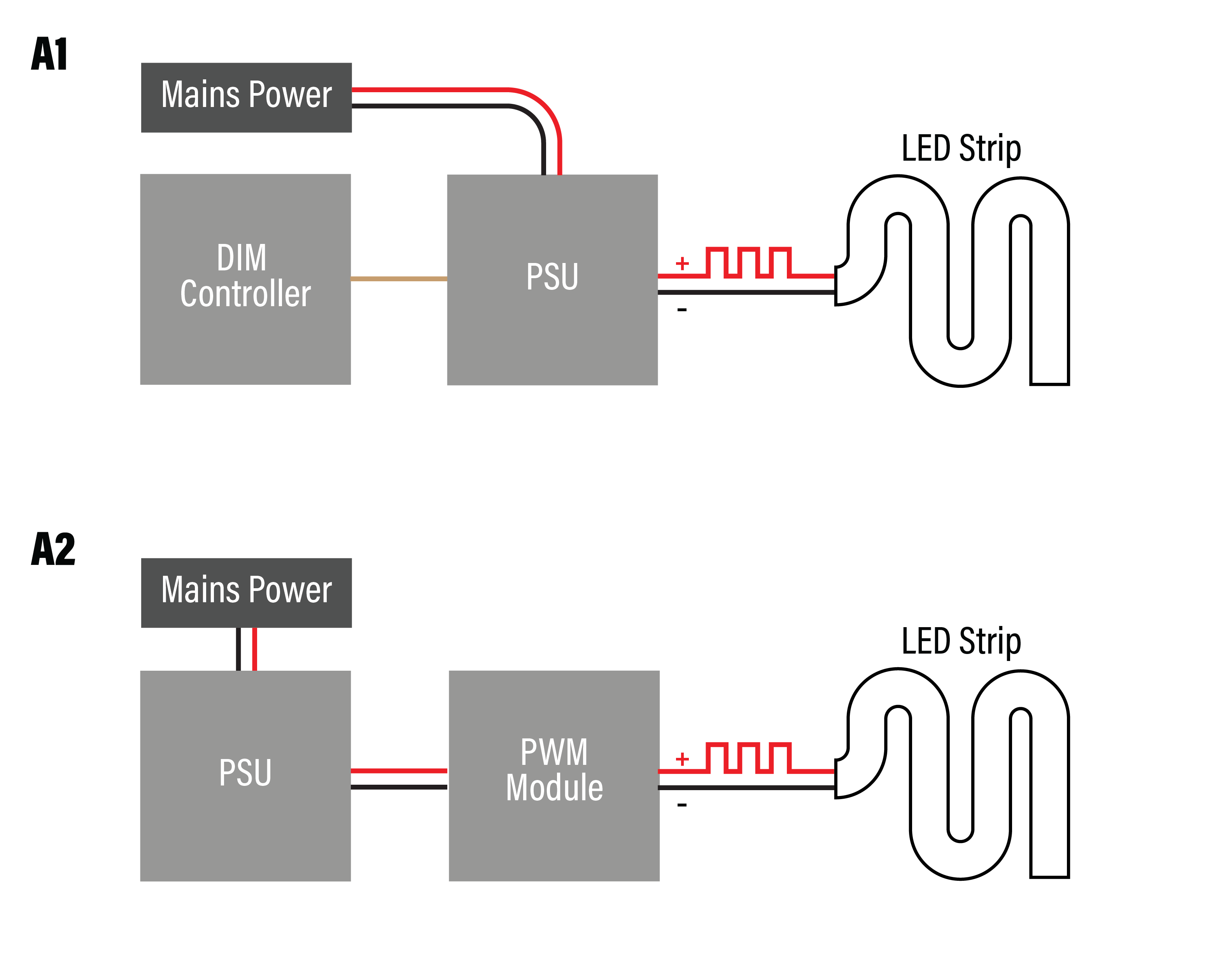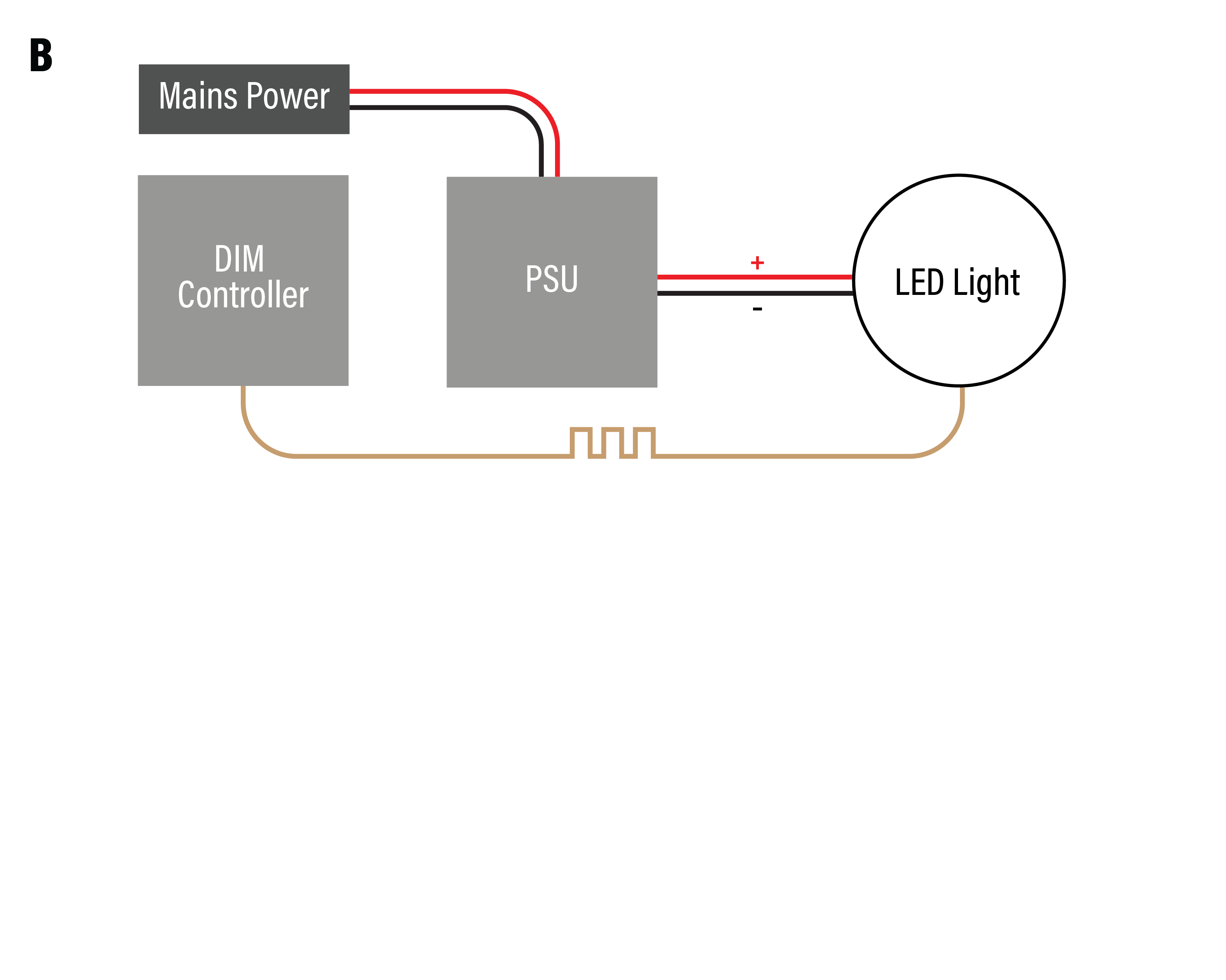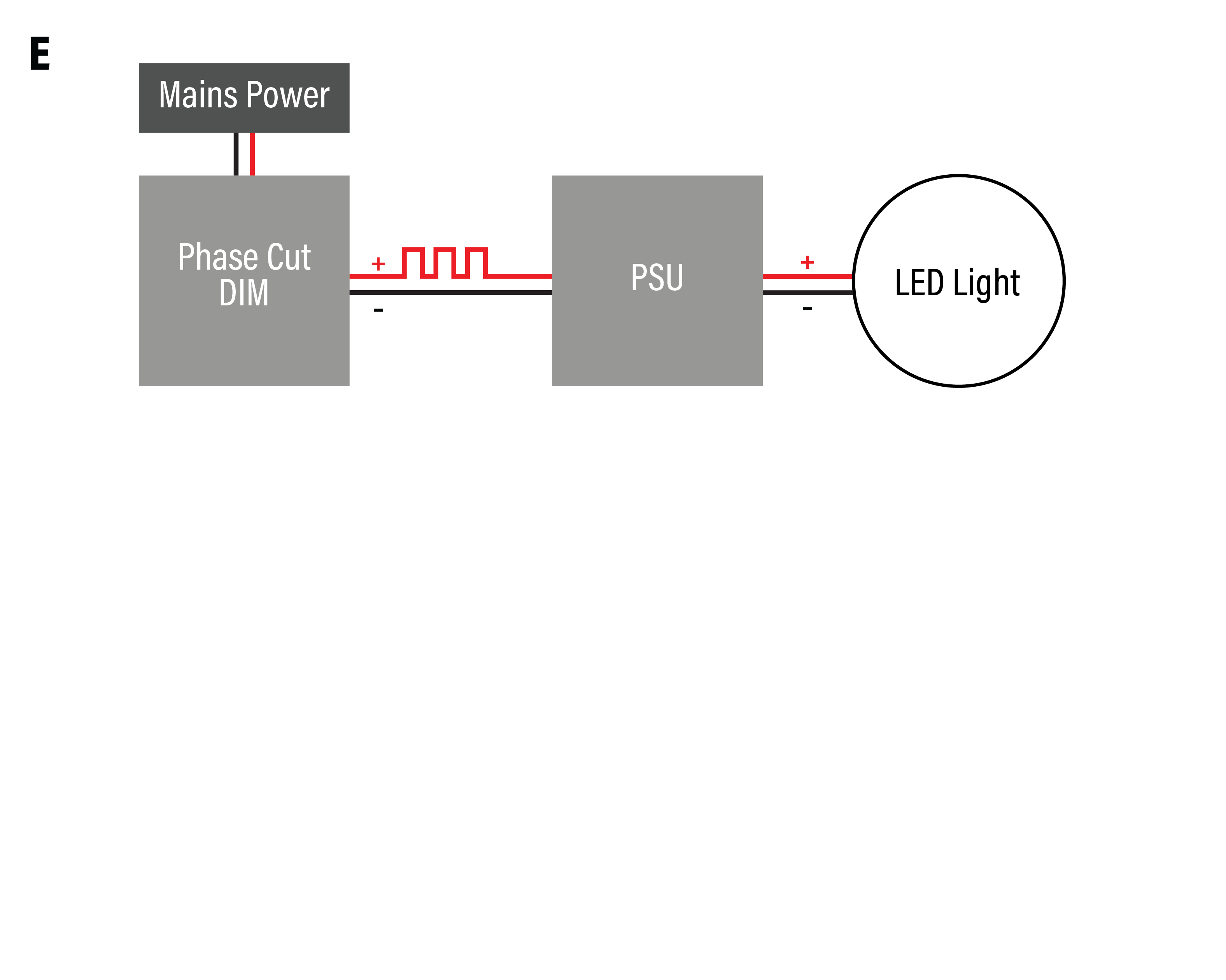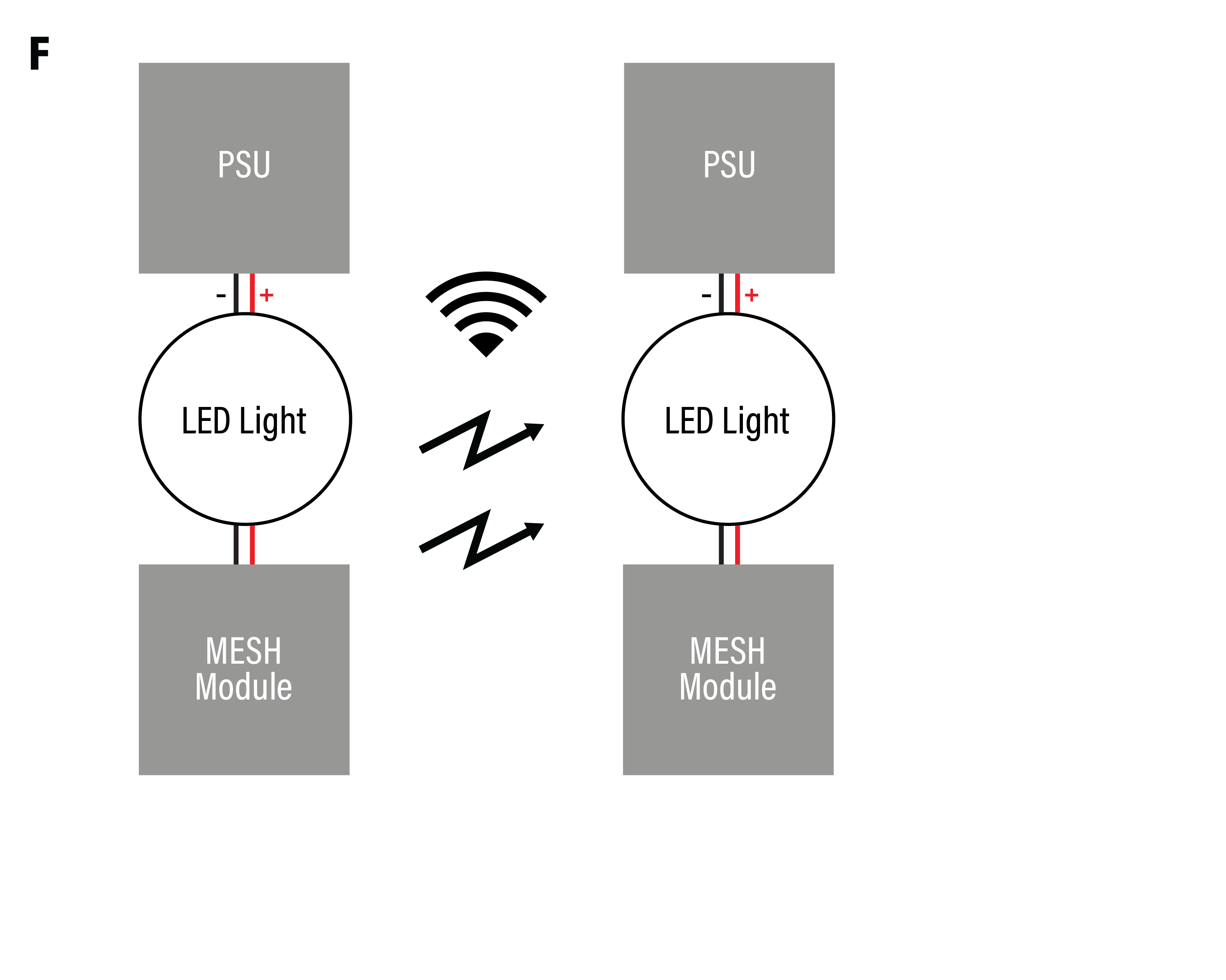
Aqualux Lighting - Dimming Gear
• Dimming LED lighting is not as simple as incandescent lighting.
• Newer systems such as DALI are more reliable and more efficient.
• Simple, standalone digital dimming systems are cost-effective and easy to install.
AQL-XXX-AA-BCCCDDEEF
Code and table definitions

Control Gear (B)
Code ‘B” in our product code scheme determines the input voltage, dimming capability, and wiring requirements.

Input Voltage
Refers to the voltage and current type needed to supply the light.

Dimming
If the driver is capable of dimming, what style of dimming it is and other details.

Recommended Hardware
Example equipment required to operate the particular configuration and any dimming capability.

Notes
Particular instructions directly related to the fitting and selected components.

Wiring Diagrams
Overview of the electrical circuit, the relative position, and arrangement of fittings, and control gear.
Aqualux Internal Control Gear - Dimming Reference
| Code (B) | Input Voltage | Dimming capability | Recommended Hardware | Notes | Wiring Diagram |
|---|---|---|---|---|---|
X |
12~24V AC 24V DC. MultiVoltage. |
DALI (via PWM 10V Signal Dimming) (with 3-wire products) |
Requires Meanwell DAP-04 (DALI/PWM Interface). Can use standalone DALI dimmers or with DALI application controllers. |
PWM Signal dimming. Requires PWM wire to be connected. No PWM = 100% Output. Single Channel 10V PWM “ High Side” dimming. |
3 |
D |
24V AC. | TRIAC / Phase Cut Dimming | Requires AQO 24V AC Power Source. Compatible Phase Cut Dimmers include: Clipsal UDM450E, Diginet MEDM. |
Dimming performance is best when load is > 80% of power supply rating. |
30 |
Z |
24V DC. | 4CH PWM Dimming, Common Anode |
Suitable control modules include LTECH T4 Modules and DMX Interfaces. |
4 Channel “Low Side” PWM dimming for RGBW systems. Requires 500Hz (nominal) PWM signal source with common 24V+ anode. No PWM = 0% Output. |
7, 15, 27, 28, 29 |
E |
24V DC. | PWM Dimming (Power) | Suitable control modules include LTECH T1 CV, AQD PWM Dimmers. Suitable power supplies include Meanwell HLG-B, Meanwell PWM drivers. |
Requires PWM dimmer module or PWM dimming power supply. Power supply will also offer additional dimming methods (0-10V, DALI, DMX etc). |
7, 8,
|
B |
24V DC. | DALI / PWM (10V) Signal Dimming. (with 3-wire products) |
24V DC Only (Not dimmable on AC). Utilises the Meanwell DAP-04 (DALI Interface). Can use standalone DALI dimmers or with DALI application controllers. |
PWM Signal dimming. Requires PWM wire to be connected. No PWM = 100% Output. Single Channel 10V PWM “High Side” dimming. |
3 |
L |
24V DC. | DALI Dimming, Integral | Integrated DALI compatible LED driver. Requires 2-wire DALI signal control in addition to 24V DC power. Requires DALI application controller or standalone dimmer control unit. |
Check DALI wiring regulations when used together with SELV lighting systems. |
32 |
M |
MR16 | Lamp Dependant. | Lamp Dependant. | Lamp Dependant. |
- |
G |
GU10. | Lamp Dependant. | Lamp Dependant. | Lamp Dependant. |
- |
F |
240V AC. | Control Gear Dependant. |
- |
||
H |
24V AC/DC. | PWM (Power) Dimming | Suitable control modules include LTECH T1 CV, AQD PWM Dimmers. Suitable power supplies include Meanwell HLG-B dimming power supplies. |
24V DC PWM Power dimming. Requires PWM dimmer module or PWM dimming power supply. |
- |
J |
12V DC. | PWM (Power) Dimming | Suitable control modules include LTECH T1 CV, AQD PWM Dimmers. Suitable power supplies include Meanwell HLG-B dimming power supplies. |
12V DC PWM Power dimming possible. Requires PWM dimmer module or PWM dimming power supply. |
- |
K |
24V DC. | Non Dimming. |
- |
||
Y |
12~24V AC / 24V DC. | Non Dimming. |
- |
||
W |
24V DC. | Non Dimming. |
- |
LED Strip and String Lighting reference guide
| Product Group | Input Voltage | Dimming capability | Recommended Hardware | Wiring Diagram |
|---|---|---|---|---|
| AQS Neon Flex and COB Strip (Mono) AQF Festoon AQF Fairy |
24V DC | PWM (Power) Dimmable. | DALI Dimming - 24V DALI Compatible PSU eg. Meanwell -DA PSU - DALI Standalone Dimmer eg. AQD-400-ZEN - or integrated DALI system Phasecut Dimming - 24V Phasecut Compatible PSU eg. AQD-PS-PDV Series - Compatible phasecut dimmer eg. Diginet MEDM SELV PWM Dimming - 24V Non-dimmable PSU eg. AQD24 series - Low-voltage PWM Dimmer eg. AQD-400-T3CV Series 0-10V Dimming - 24V 0-10V Compatible PSU eg. Meanwell HLG-B Series - 0-10V Dimming Unit eg. AQD-400-DIM-001 DMX Dimming - 24V Non-dimmable PSU eg. AQD24 series - DMX > PWM Interface Module eg. AQD-400-LT844 - DMX Controller |
31 |
| AQF Festoon | 24V AC. | TRIAC / Phase Cut Dimming. | AQO 24V AC Power Supply + Compatible Phase Cut Dimmer eg. Clipsal UDM450E, Diginet MEDM |
30 |
| AQS Neon Flex and COB Strip (RGB/RGBW) |
24V DC | 3CH / 4CH PWM (Power) Dimmable RGB/RGBW Controller Reqd. |
DMX Control - 24V Non-dimmable PSU eg. AQD24 series - DMX > PWM Interface Module eg. AQD-400-LT844 - DMX Controller Remote RGB/RGBW Control - 24V Non-dimmable PSU eg. AQD24 series - Low-voltage PWM Dimmer eg. AQD-400-T3CV Series - RF Remote Control eg. AQD-400-T3/T4 |
4, 6 |
3-Wire Dimming (PWM Signal)
The preferred method for controlling wired LED fixtures, where 2-wires carry the power and a 3rd wire carries the dimming / control signal. When controlled in this way, LED fixtures can provide optimal efficiency, stability and dimming range. Many Aqualux fixtures support 3-wire dimming which can be easily interfaced to DALI, DMX or wireless control systems.
2-Wire Dimming (PWM Powerline)
Dimming LED products using only 2-wires requires that the fixtures or products are Constant Voltage in nature and compatible with this method. This includes most LED strip, LED festoon and some specific LED fixtures that are designed to be used with a 2-wire system. Please check individual fixture datasheets and wiring guides before assuming 2-wire dimming will work.
Phase Cut Dimming
Phasecut (including TRIAC) dimming is not recommended for LED lighting systems. Some Aqualux products are compatible as noted below, however the majority are not. It is an outdated approach to controlling LED lighting loads with several issues (dimming ratio issues, off-peak signal interference) and there are several newer and better methods that should be used instead.
Aqualux 10V PWM Dimming
Aqualux fittings with 10V PWM dimming are controlled via a separate dimming signal wire when it is connected to a compatible PWM source such as the DAP-04 DALI interface. This is not the same as 0-10V or 1-10V DC analog dimming. See ‘Technical Information’ for more information.
Aqualux PWM Dimming / 10V PWM Voltage / 1% - 100% / 500Hz
1
The dimming capability of Aqualux products is determined by the control gear code and power source.
2
Selecting the right option is important if you require a form of dimming for your lighting system.
3
To determine Aqualux dimming compatibility, locate the control gear code ‘B’ in your product code.
4
Refer to the table below to determine the dimming capabilities and what control gear is needed.
The control and dimming of lighting products are not as straightforward as it once was with halogen or incandescent lighting. There are multiple options and methods for dimming and control LED lights. Once manufactured, dimming compatibility cannot be changed without returning the product to our factory for modification. Refer to the table at the end of this document for more information on dimming control systems. While Phase-cut/TRIAC dimming systems can still work with some LED products, there are also other legacy systems such as 0-10V (developed for fluorescent lighting) and more modern digital lighting control systems such as DALI and DMX that are in many ways more suitable for LED lighting control.
Aqualux 10V PWM Dimming Aqualux fittings with 10V PWM dimming are capable of dimming if the PWM signal wire is connected to a compatible 10V PWM source such as the DAP-04 DALI interface. See page 4 for more information.
Don’t hesitate to contact us if you have any questions or go to 'Downloads / Catalogues & Guides / Dimming Guide' for a PDF version, or simply Click Here.
Wiring diagrams can be downloaded by clicking on the 'numbers' in the tables.
CBUS Dimming
The ability of CBUS to dim LED lighting system depends on the modules available within the CBUS system and the type of dimming required by the LED driver or power supply.
Dimming with CBUS:
- Use a Phasecut CBUS dimming module with a compatible Phasecut power supply.
- Use a CBUS/DALI gateway and a DAP-04 for Compatability with Aqualux 10V PWM dimming.
Universal (Phasecut) Dimming Module:
- C-Bus DIN Rail Mounted DALI Gateway for 2 Dali Networks
Item Number: 5502DAL
CBUS / DALI Gateway
DIN Rail Mounted, Universal, 240V AC, 4 Channel, 2.5A.
Item Number: L5504D2UP.
Technical Information

PWM (Power) DIMMING
PWM power dimming directly modifies the output of a power supply via PWM (Pulse-width modulation). It controls how often the current is on or off hundreds of times per second.
As the human eye cannot perceive frequencies this fast, the effect is an apparantly stable variation of the output light level.
PWM power dimming can be achieved by using compatible power supplies that will require their own dimming control input. It can also be achieved by using a PWM module that sits between the power supply and lighting product and modifies the power to control the PWM dimming.
PWM Power dimming is common in LED strip lighting products and operates across any number of channels (eg. White, Tuneable White, RGB, RGBW).
The benefits of PWM power dimming are that it is relatively straightforward requiring no additional wires, that it works independent of the load rating of the power supply and that it does not require additional signal wires.
The drawbacks include that the LED forward voltage must be closely matched (linear) with the power supply voltage - Many discrete LEDs require voltages that are not common and are difficult to control in a linear fashion.
This is why PWM Power dimming is most commonly used with LED Strip lighting type products where multiple LEDs can be combined to create a 12V or 24V LED circuit.

PWM (Signal) DIMMING
PWM Signal dimming directly controls the output current of a power supply, either an internal constant current driver inside a light fitting or an external constant current or constant voltage power source.
The driver or power supply requires a separate control signal wire that the PWM signal is delivered over. The PWM signal is then used by the driver to modify the output current to the LED.
The advantages of this approach are that multiple individual fittings can be controlled with the same dimming signal and that it operates independent of the internal LED voltage. A variety of types of fittings can be controlled in the same manner.
Many other forms of lighting control are in fact interfaces to a PWM Signal type of dimming, given that close to the LED a PWM signal of some sort will almost always be needed to modify the LED output.

DALI
DALI (Digital Addressable Lighting Interface) is a modern lighting control protocol. It allows each device to be individually addressed and controlled.
The benefits of DALI are relative ease of deployment and commissioning, with each fixture or driver assigned an address and independently controlled.
The drawbacks include the requirement for additional components such as a DALI power supply and typically a master controller. Additionally, DALI wiring rules specify that the control cables (although ELV) must be treated as 240V.
This simplifies wiring in mains powered lighting systems but may complicate requirements in SELV systems.
Aqualux fittings that are DALI compatible typically use a DALI/PWM interface to provide this control. This means that control is available down to the power supply group rather than individual fitting.

DMX512
DMX (Digital Multiplex) is a common digital protocol for the control of entertainment lighting and architectural systems.
Developed initially for linking theatrical lighting and effects systems to central controllers, it has expanded to include many other functions.
DMX requires a separate set of control cables to carry the data signals from a central controller to the lighting control systems and power supplies. It can be used with both low voltage and mains lighting products as the control system is completely separate from the lighting power supply system.
The benefits of DMX512 are that it is a widely used and well-understood system with many compatible control products. Very long signal cable runs are also possible, up to 1km or more. Wireless DMX equipment is also available.
The main drawback is that DMX requires additional control equipment and adds complexity to a system beyond what is typical for residential applications. Many fittings will also require an interface module to convert the digital DMX512 signal to PWM signal.

Phase cut / TRIAC
Phase cut dimming includes both TRIAC-based dimming (leading edge) and trailing edge approaches.
There are also “universal” dimmers that can determine the most appropriate mode for the detected load. The benefits of phase-cut dimming are that it is simple to install and widely understood by most contractors.
The drawbacks include incompatibility with many LED products and varying performance that depends on the combination of dimmer, power supply, and LED light.
Some manufacturers recommend only certain combinations of dimmers and power supply units.

Mesh Networks (Zigbee, Casambi, Silvair)
There are a growing number of mesh network protocols intended for wireless control of lighting and other building systems. Casambi and Silvair operate using Bluetooth mesh networks, whereas Zigbee utilises its own radio communication method.
Casambi in particular is growing in popularity and Aqualux will soon be able to offer a range of options for control of fittings and strip lighting with Casambi products.

ARTNET
ArtNET is a protocol for transmitting DMX/RDM signals over Ethernet. It can make the deployment of a DMX solution a lot easier as it can utilise existing infrastructure.
